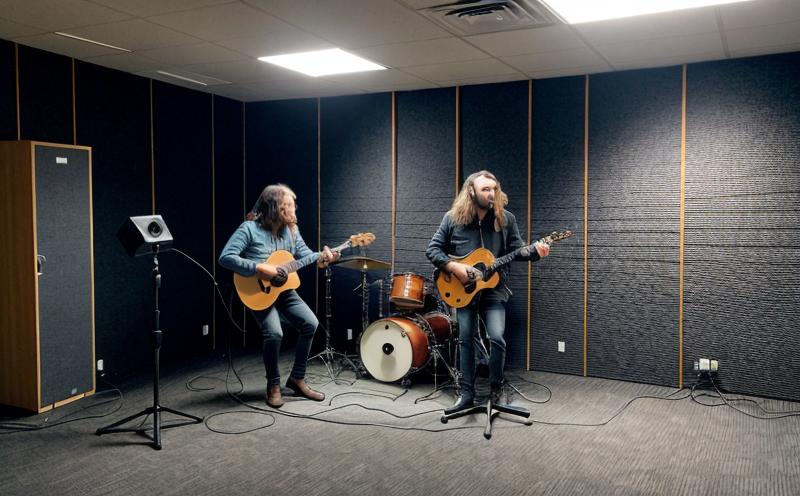ASTM E2235 Sound Insulation and Absorption Testing
The ASTM E2235 standard provides a method for determining the sound insulation of building materials. This test is particularly useful in assessing the noise reduction capabilities of various construction components, including walls, floors, ceilings, and partitions. The primary focus of ASTM E2235 is to measure the transmission loss (TL) values between two rooms separated by a partition under controlled conditions.
The testing methodology involves creating sound pressure differences on both sides of a partition using a sound source in one room while measuring the resulting sound pressure levels and their associated phase angles in the receiving room. The test setup includes specific equipment such as noise generators, microphones, signal processors, and calibrated amplifiers to ensure accurate measurements.
The ASTM E2235 standard is widely used by architects, engineers, contractors, and quality managers to comply with building codes and standards that require sound insulation testing. This ensures that buildings meet the necessary acoustic performance requirements for occupant comfort and privacy.
One of the key aspects of ASTM E2235 involves specimen preparation. Specimens are typically cut from actual construction materials or elements used in walls, floors, ceilings, and partitions. These specimens must be free from defects such as holes, cracks, or irregularities that could affect sound transmission characteristics.
The test setup includes a series of steps to ensure consistent results. The first step involves placing the specimen between two rooms with controlled conditions for temperature, humidity, and air flow. Sound is generated in one room using specified noise sources, while microphones are placed at specific points in both rooms to measure sound pressure levels and phase angles.
The resulting data is then analyzed to calculate transmission loss values, which represent the reduction in sound energy passing through the partition. Compliance with ASTM E2235 requires that these values meet or exceed specified thresholds for various frequency bands. This ensures that the tested materials provide adequate sound insulation.
ASTM E2235 is applicable not only to building materials but also to HVAC equipment, where noise reduction and control are critical factors in creating a comfortable indoor environment. In HVAC systems, sound insulation testing helps identify potential sources of noise pollution and assess the effectiveness of various components designed to mitigate such issues.
The ASTM E2235 standard is essential for quality assurance and compliance with international standards like ISO 140-4 and EN ISO 717-1. By adhering to these guidelines, laboratories can ensure that their testing results are reliable and consistent across different environments and conditions.
Benefits
- Enhanced Quality Assurance: ASTM E2235 ensures that all tested materials meet the required acoustic performance standards, enhancing overall product quality.
- Compliance with Regulations: By adhering to international standards like ASTM E2235, laboratories can ensure compliance with local and international regulations regarding noise pollution and indoor acoustics.
- Improved Product Reputation: Consistent, high-quality testing results enhance the reputation of manufacturers and suppliers in the HVAC sector.
- Increased Market Share: Meeting or exceeding acoustic performance standards can help gain a competitive edge over other products in the market.
Why Choose This Test
The ASTM E2235 sound insulation and absorption test is crucial for several reasons. Firstly, it provides reliable data on the noise reduction capabilities of various materials, which is essential for improving indoor acoustics in buildings.
Secondly, this test helps identify potential sources of noise pollution within HVAC systems. By isolating and testing specific components, manufacturers can pinpoint areas that need improvement to enhance overall system performance.
In addition, ASTM E2235 ensures consistency across different environments and conditions, making it an indispensable tool for laboratories aiming to maintain high standards in their testing processes. This consistency is particularly important when dealing with international clients who require compliance with various standards.
Finally, the test results obtained from ASTM E2235 can be used to inform design decisions, ensuring that new constructions and renovations meet the necessary acoustic performance requirements for occupant comfort and privacy.
Competitive Advantage and Market Impact
- Differentiation in the Market: Laboratories offering ASTM E2235 testing services can differentiate themselves by providing reliable, accurate results that meet international standards.
- Innovation Facilitation: By ensuring compliance with ASTM E2235, manufacturers and suppliers can stay ahead of regulatory changes and market trends in the HVAC sector.
- Enhanced Client Satisfaction: Clients who rely on reliable testing results for their products or projects benefit from the confidence that comes with knowing they are meeting international standards.
- Increased Market Share: By offering ASTM E2235 testing, laboratories can attract more clients and increase their market share by demonstrating a commitment to quality and accuracy in testing services.
The impact of ASTM E2235 extends beyond individual projects; it contributes to the overall improvement of acoustic performance across various industries. By ensuring that materials meet strict sound insulation standards, laboratories play a crucial role in creating healthier and more comfortable indoor environments for occupants.





